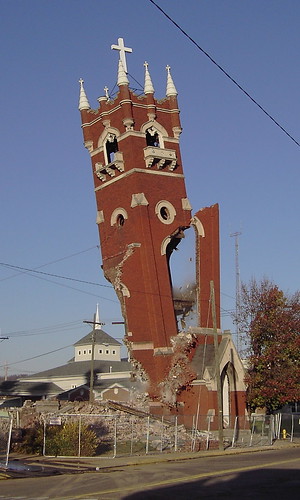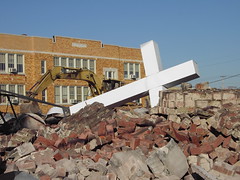
Architectural Blight
The over-privileged of Portsmouth , Ohio the city city
 |
| When the Cross Came Crashing Down |
Since the cross is the most sacred symbol of Christianity, I expected at some point prior to the demolition of the tower that it would be carefully if not reverentially removed. Certainly the time and small additional expense that removing the cross entailed should have been no impediment to removing and safely storing it. There is a protocol for the treatment and disposal of American flags. Isn’t there also for the treatment and disposal of crosses? My curiosity about the cross increased after I heard a news report about the bombing of two Shiite mosques in Iraq
 |
| Cross Rusting in Two Pieces Months Later |
On Saturday, November 19, 2005 , another of the city’s architectural treasures, the old Methodist church at the northwest corner of Gallia and Offnere Streets was torn down to make way for a parking lot. As it scrambled to survive, the Methodist church changed names several times. To distinguish it from the new Methodist church on the northeast corner of Offnere and Gallia , I will refer to the old one on the northwest corner by one of its previous names, the Wesley United Methodist Church
Shall We Gather at the Wrecking of the Church?
Though it was a mild afternoon, only a handful of curious onlookers had gathered on Gallia Street Portsmouth
Possibly the crowd would have been larger if Ohio State had not been playing Michigan that afternoon, which may have been why some of the spectators remained in their cars – to listen to the Buckeyes, for whom there is a kind of religious devotion and even fanaticism throughout Ohio. If there were state religions, as there are state flowers, birds, and songs, Ohio Ohio State
Most of the people sitting in their cars and standing around in small groups appeared to be curiosity seekers who were willing to wait hours to see the four-second spectacle of a tower crashing to the ground, just as pedestrians might gather silently on a street of New York City to watch someone on a ledge jump to his death, or just as a crowd might have gathered to see a public hanging or a burning at the stake in Europe in the Age of Faith. “Portsmouth Portsmouth
The Methodists had sold the old church and the site to the neighboring Holy Redeemer [Catholic] Church, which wanted the land for a parking lot. According to a Catholic friend of mine, the Holy Redeemer Church
I had followed the demolition for several weeks and especially wanted to see what would happen to the large white cross in the tower of the old church. I had learned that a cross had first been added to the church tower in 1930. Because it was illuminated by screw-in light bulbs, like an old marquee, and because it also revolved, the cross was something to behold on Portsmouth
The revolving cross was later replaced by the seven-foot white hollow sheet metal cross that remained on the top of the tower until the demolition of November 19, 2005. Another older member of the church told me she was present at a dedication ceremony for the new cross, suggesting that the putting up, if not the taking down, of a cross was a still an occasion for solemn commemoration. The contrast between the Muslims’ reverence for copies of the Koran and the Methodists’ casual attitude toward the cross may reveal something important about differences between Islam and Christianity, and particularly the tactical advantages the followers of Mohammed have over the followers of Christ. Muslims and Christians both believe in their faith, but, judging by actions, not words, the Muslims believe more fervently in their faith than Christians do in theirs. The Muslims are more willing to kill and sacrifice their own lives for their faith than Christians are, which gives them an enormous tactical advantage in the religious war in which the U.S. and Islamic fundamentalists are now engaged. Muslim places of worship are places of worship, not glorified daycare centers, which is what I heard someone call the new Cornerstone United Methodist Church on the northeast corner of Gallia and Offnere.
As I understand it, there is a place for worship in the new Cornerstone Church
There are rumors that other beautiful and historic Portsmouth Portsmouth Portsmouth Portsmouth

Through transfusions of pork and higher taxes, the Marting Foundation is attempting to preserve the Marting department store as a shrine to the commercial spirit of Portsmouth Portsmouth